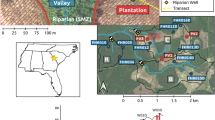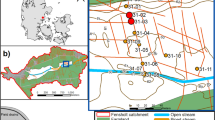Abstract
Movement of agricultural nitrogen (N) into riparian buffers often occurs within discrete seepage or upwelling zones which can limit the ability of the ecosystem to process the nutrient delivered by exfiltrating groundwater. Characterization of the biogeochemical processing of N within these zones is important in assessing the effectiveness of riparian buffers for mitigating nutrient loading of surface waters. The biogeochemical potential for denitrification in zones of exfiltration within a riparian buffer wetland dominated by high-carbon mucky soils was found to be highly stratified by profile depth with substantially higher activity in the surface layer of soil. The denitrification enzyme activity (DEA) within these zones was partly related to the population size of denitrifying microorganisms as measured by the most probable number (MPN) as well as the general microbial population as measured by substrate-induced respiration. The addition of glucose to the DEA assay stimulated enzyme activity indicating that carbon substrate was limiting activity. The stratification patterns of microbial populations and DEA are consistent with new carbon inputs to the ecosystem being most important driver of biogeochemical reactions such as denitrification in this high-carbon environment. A survey of carbon inputs to the ecosystem under study identified two major sources that contribute most of the annual biomass carbon inputs to the wetland: skunk cabbage in early summer and tree leaf litter in the fall. Tests of the ability of annually deposited wetland plant residues to stimulate denitrification and microbial respiration indicated that the degree of stimulation was inversely related to the C/N ratio of these carbon sources.






Similar content being viewed by others

References
Angier, JT, McCarty GW, Gish TJ, Daughtry CST (2001) Impact of a first-order riparian zone on nitrogen removal and export from an agricultural ecosystem. The Scientific World 1(S2):642–651
Angier JT, McCarty GW, Rice CP, Bialek K (2002) Influence of a riparian wetland on nitrate and herbicides exported from an agricultural field. J Agric Food Chem 50:4424–4429
Angier JT, McCarty GW, Rice CP, Bialek K (2004) Improving riparian zone function by identifying critical areas with limited mitigation capacity. Proceedings of the American Water Resource Association, Summer Specialty Conference: Riparian Ecosystems and Buffers, Olympic Valley CA CD-ROM, p 6
Angier JT, McCarty GW, Prestegaard KL (2005) Hydrology of first-order riparian zone and stream, mid-Atlantic coastal plain, Maryland. J Hydrol 309:149–166
Baumann, B, Snozzi M, Sehnder JB, van der Meer JR (1996) Dynamics of denitrification activity of Paracoccus denitrificans in continuous culture during aerobic-anaerobic changes. J Bacteriol 178:4367–4374
Casey RE, Taylor MD, Klaine SJ (2001) Mechanisms of nutrient attenuation in a subsurface flow in riparian wetland. J Environ Qual 30:1732–1737
Clement JC, Pinay G, Marmonier P (2002) Seasonal dynamics of denitrification along topohydrosequences in three different riparian wetland. J Environ Qual 31:1025–1037
Cosandey AC, Maitre V, Guenat C (2003) Temporal denitrification patterns in different horizons of two riparian soils. Eur J Soil Sci 54:25–37
Davidsson TE, Stahl M (2000) The influence of organic carbon on nitrogen transformations in five wetland soils. Soil Sci Soc Am J 64:1129–1136
Devito KJ, Fitzgerald D, Hill AR, Aravena R (2000) Nitrate dynamics in relation to lithology and hydrologic flow path in a river riparian zone. J Environ Qual 29:1075–1084
Dhondt K, Boeckx P, Hofman G, Van Cleemput O (2004) Temporal and spatial patterns of denitrification enzyme activity and nitrous oxide fluxes in three adjacent vegetated riparian buffer zones. Biol Fertil Soils 40:243–251
Flite OP III, Shannon RD, Schnabel RR, Parizek RR (2001) Nitrate removal in a riparian wetland of the Appalachian valley and ridge physiographic province. J Environ Qual 30:254–261
Gold AJ, Jacinthe PA, Groffman PM, Wright WR, Puffer RH (1998) Patchiness in groundwater nitrate removal in riparian forest. J Environ Qual 27:146–155
Groffman PM, Gold AJ, Simmons RC (1992) Nitrate dynamics in riparian forests: microbial studies. J Environ Qual 21:666–671
Groffman PM, Hanson GC, Kiviat E, Stevens G (1996a) Variation in microbial biomass and activity in four different wetland types. Soil Sci Soc Am J 60:622–629
Groffman PM, Howard G, Gold AJ, Nelson WM (1996b) Microbial nitrate processing in shallow groundwater in a riparian forest. J Environ Qual 25:1309–1316
Hanson GC, Groffman PM, Gold AJ (1994) Denitrification in riparian wetlands receiving high and low groundwater nitrate inputs. J Environ Qual 23:917–922
Herbert R (2005) Vegetation and nutrient dynamics of forested riparian wetlands in agricultural settings. M.S. thesis, University of Maryland, College Park. (http://hdl.handle.net/1903/2547)
Hill AR (1996) Nitrate removal in stream riparian zones. J Environ Qual 25:743–755
Hill AR, Cardaci M (2004) Denitrification and organic carbon availability in riparian wetland soils and subsurface sediments. Soil Sci Soc Am J 68:320–325
Hill AR, Devito KJ, Campagnolo S, Sanmugadas K (2000) Subsurface denitrification in forest riparian zone: interactions between hydrology and supplies of nitrate and organic carbon. Biogeochemistry 51:193–223
Hill, A.R, Vidon PGF, Langat J (2004) Denitrification potential in relation to lithology in five headwater riparian zones. J Environ Qual 33:911–919
Kellogg, DQ, Gold AJ, Groffman PM, Addy K, Stolt MH, Blazejewski G (2005) In situ ground water denitrification in stratified, permeable soil underlying riparian wetlands. J Environ Qual 34:524–533
Lowrance R (1992) Groundwater nitrate and denitrification in a coastal plain riparian forest. J Environ Qual 21:401–405
Lowrance RR, Todd R, Fail J, Hendrickson O, Leonard R, Asmussen L (1984) Riparian forests as nutrient filters in agricultural watersheds. Bioscience 34:374–377
Lowrance R, Vellidis G, Hubbard RK (1995) Denitrification in a restored riparian forest wetland. J Environ Qual 24:808–815
McCarty GW, Angier J (2000) Impact of preferential flow pathways on ability of riparian wetlands to mitigate agricultural pollution. Proceedings of second international symposium on preferential flow, pp 53–56
Mookherji S, McCarty GW, Angier JT (2003) Dissolved gas analysis for assessing the fate of nitrate in wetlands. J Am Water Resour Assoc 39:381–387
O’Connell M (1998) Combined hydrologic and geochemical study of storm and seasonal delivery of solutes to streamflows. Ph.D. thesis, University of Maryland, College Park
Pinay G, Roques L, Fabre A (1993) Spatial and temporal patterns of denitrification in a riparian forest. J Appl Ecol 30:581–591
Schipper LA, Cooper AB, Harfoot CG, Dyck WJ (1993) Regulators of denitrification in an organic riparian soil. Soil Biol Biochem 25(7):925–933
Schnabel RR, Cornish LF, Stout WL, Shaffer JA (1996) Denitrification in a grassed and a wooded, valley and ridge, riparian ecotone. J Environ Qual 25:1230–1235
Tiedje JM (1994) Denitrifiers. In: Weaver RW et al (ed) Methods of soil analysis. Part 2, 5th edn. Soil Science Society of America publication, pp 245–267
West A, Sparling G (1986) Modifications to the substrate-induced respiration method to permit measurement of microbial biomass in soils of differing water content. J Microbiol Methods 5:177–189
Woomer PL (1994) Most probable number counts. In: RW Weaver et al (ed) Methods of soil analysis. Part 2, 5th edn. Soil Science Society of America publication, pp 59–79
Author information
Authors and Affiliations
Corresponding author
Rights and permissions
About this article
Cite this article
McCarty, G.W., Mookherji, S. & Angier, J.T. Characterization of denitrification activity in zones of groundwater exfiltration within a riparian wetland ecosystem. Biol Fertil Soils 43, 691–698 (2007). https://doi.org/10.1007/s00374-006-0151-0
Received:
Revised:
Accepted:
Published:
Issue Date:
DOI: https://doi.org/10.1007/s00374-006-0151-0



